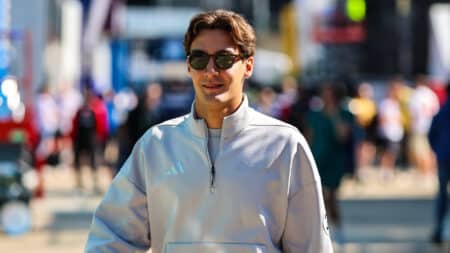
How Russell reacted to Verstappen - Mercedes rumours at Silverstone
George Russell says his chances of leaving Mercedes at the end of the year are "exceptionally low"
Forty years ago Penske Racing was getting ready to run its first full Formula 1 season. Roger Penske debuted his first F1 car, the PC1, at the end of 1974 at the Canadian and United States GPs at Mosport and Watkins Glen. Mark Donohue came out of a short retirement to test and race the PC1 before deciding he was going to race the car full-time in 1975.
Penske bought his English car-building shop from Graham McRae in November 1973. McRae had built successful Formula 5000 cars at the shop located on the Creekmoor Trading Estate in Poole, Dorset. Penske assigned Heinz Hofer to manage building and racing his new F1 cars. From Switzerland, Hofer was multilingual. Penske met him while skiing in Colorado and hired Hofer to run his turbo Porsche Can-Am team in 1972 and ’73. At the end of ’73 Penske posted Hofer to the UK to oversee his brand new F1 operation.

Penske Cars’ first home occupied just 5000 square feet and employed only half a dozen people, Hofer included. Geoff Ferris was the engineer and designer and there were two fabricators, a parts runner and a secretary. Ferris designed the PC1 and when Karl Kainhofer arrived in Poole in the summer of 1974 the first chassis and most of the suspension pieces had been built.
Kainhofer was Penske Racing’s chief mechanic from the start when Roger founded his team in 1966. Kainhofer had worked on Penske’s cars in Roger’s driving days in the late ‘50s and early ‘60s and he was Penske’s first hiring, even before he signed Donohue to lead his new team. Kainhofer was Donohue’s chief mechanic on all his Can-Am cars from 1966-72 and every Indycar Donohue drove from 1968-73.
In the spring of ’74 Penske asked Kainhofer to fly to England and start putting together the PC1. The job was done by late summer and the car was flown to the USA for a public unveiling before its first race in Canada in September. “I was the first guy to actually test the car on the skid pad,” Kainhofer recalls. “We tested it a little bit on the skid pad and after I ran the car around there for a little while Donohue decided he wanted to give it a try. Mark got in it and drove it on the skid pad and then we went testing a little bit. That’s when he decided if he was going to test it, he might as well race it.”

Donohue was unhappy out of the cockpit working as Penske’s team manager and engineer. He yearned to get back behind the wheel and after getting a taste of the F1 car he decided to come back to racing in September to debut the new car at the last two races of 1974.
At Mosport Donohue qualified 24th in a field of 30 cars and finished the race in 12th place, two laps down, running some respectable lap times as the race wore on. At the Glen he qualified an encouraging 14th – within two seconds of pole-winner Carlos Reutemann’s Brabham – but dropped out of the race when a rear suspension bracket broke.
The experience convinced Donohue to race the F1 car full-time and he set out to run the full World Championship schedule in 1975. During the winter a second PC1 was built but Donohue struggled with it in practice and qualifying in Argentina. He was six seconds off the pace on the first day but was able to make some progress, eventually qualifying 15th. In the race he worked his way up to finish seventh, remaining unlapped until the last few laps by winner Emerson Fittipaldi’s McLaren.
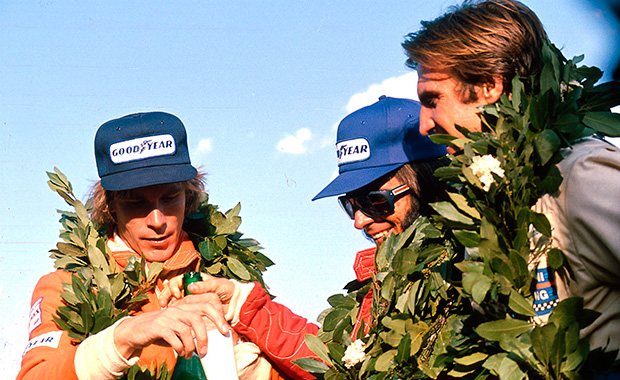
In Brazil Donohue again qualified 15th and enjoyed a good scrap with Mario Andretti’s Parnelli but then the PC1’s wing broke. In South Africa, Donohue qualified 18th and finished eighth, one lap down. Next came the non-championship Race of Champions at Brands Hatch in March where Donohue qualified seventh but pulled out of the race because of bad handling. In April, he qualified 10th and finished sixth in the non-championship Daily Express Trophy race at Silverstone.
“We had only five people going to the races that year,” Kainhofer says. “There was Mark, Heinz, and three of us working on the car. That was it. The whole F1 team was five guys. Geoff Ferris came to some races, but he worked mostly at the shop. It wasn’t like today when the engineers go to all the races. It’s a completely different world.”
The European season began in earnest with the Spanish GP at the Montjuïc Park circuit in Barcelona, a weekend badly disrupted because of the drivers’ serious worries about safety. An inspection revealed that the temporary barriers installed around the track were badly put together. As a result the first two practice sessions were delayed and the race eventually took place amid acrimonious circumstances. After qualifying 17th Donohue’s race came to an early end when he crashed on the fourth lap on oil spilled by Jody Scheckter’s blown-up Tyrrell.

Monaco was next on the schedule but the most glamorous of F1 races was a disaster for Donohue and the team. Donohue managed to qualify 16th but he hit the kerbs twice in practice and again with just nine laps to go in the race.
Then came Zolder in Belgium where Donohue started 21st after crashing in practice and finished the race a lap down in 11th. At Anderstorp in Sweden, Donohue qualified 12th beside Mario Andretti and drove a steady, strong race to finish fifth on the same lap as winner Niki Lauda. It was Donohue’s best race of the year and brought him two world championship points.
The Dutch GP at Zandvoort was next and Donohue again qualified two-thirds of the way down the field before driving a solid race to finish eighth. At the French GP at Paul Ricard he qualified 18th but dropped out after only six laps when a driveshaft broke, his only mechanical DNF of the year.
But Penske and Fred Stecher, boss of sponsor First National City Bank, decided after Zandvoort to replace the PC1 with a March 751. Kainhofer was not a fan of the decision to switch, but got on with the job of building the car at the March factory in Bicester. After minimal testing Donohue raced the March in the British GP at Silverstone.

That year’s British GP is well-remembered for a series of rain showers culminating in a dense wall of English rain arriving with fewer than 15 laps to go. In the mayhem that followed no less than 16 drivers crashed and the race was stopped. Winner Emerson Fittipaldi was the only man not to suffer a spin or incident and was also the only driver to complete all the laps run. Donohue was classified fifth but wasn’t actually running. He was one of those involved in the multi-car shunt that brought out the red flag.
“So that race was no good measure of how good the March was,” Kainhofer says. “We never really found out how bad that car was until we went to Germany. It was a chronic understeerer. It really wasn’t a good car. It was okay for a couple of laps but it was not a good car for many laps in the races.”
At the original 14-mile Nordschleife the shortcomings of the March were made clear. Donohue was a dozen seconds slower than poleman Niki Lauda’s Ferrari in qualifying and ran into tyre trouble in the race. A front tyre blew on the first lap and after limping back to the pits for a replacement the other front tyre blew part way through Donohue’s second lap.
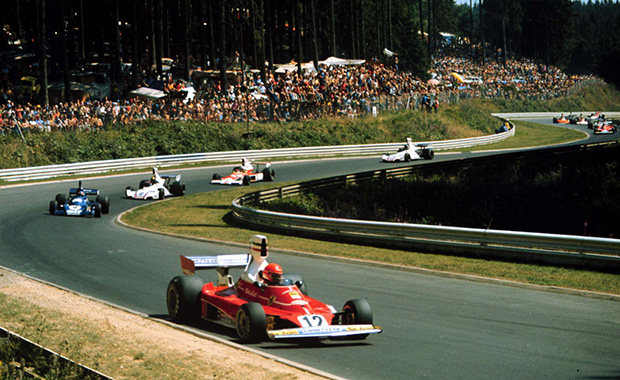
German GP: Donohue can be seen at the back of the pack in the top right corner
At the Ӧsterreichring in the middle of August Donohue qualified 18th, a little over three seconds off the pace set by Lauda and James Hunt’s Hesketh. But in the morning warm-up for Sunday’s race Donohue crashed heavily at the top of the hill beyond the pits. His car tore down more than 50 yards of catch-fencing and went over the guardrail, striking a marshals’ post before coming to a stop.
Marks on the road suggested the left front tyre had failed but the car was badly damaged and Donohue suffered a concussion. He regained consciousness at the scene of the accident and was transported to hospital complaining of a severe headache. After abruptly losing consciousness again an operation was performed to relieve the pressure on his brain but he died on Tuesday night without ever regaining consciousness. One of the injured marshals also died.
A nasty legal battle followed between Donohue’s wife and tyre supplier Goodyear. Eventually, a settlement was reached, but Kainhofer believes it was Donohue’s mistake, not Goodyear’s, because he was struggling to get the best from a badly understeering car on a high-speed circuit with mostly right-hand corners.
“It was one of those things where you make mistakes and you pay for your mistake,” Kainhofer says. “I think it ended up being a tyre pressure mistake. Donohue was his own engineer. There was nobody else calling the shots on the set up of the car. When it came to tyres Mark dictated the pressures.

“The crash in Austria probably wouldn’t have happened in today’s world because the tyre pressure sensors would have stopped him. The engineers would have told him to stop. Today, you can control those things from the outside, but in those days you sat in the car and drove it without any outside data. You went by feel and that was it. Even if it felt wrong most of them would carry on anyway. It was a different way, a different era.”
Donohue’s death also brought an end to Kainhofer’s life on the road as a racing mechanic. He decided to return home at the end of 1975 and take over running Penske’s engine shop. For the last 21 years of his career through his retirement in 1997 he built Penske’s Indycar engines – Cosworth, Ilmor/Chevrolet and Mercedes-Benz – accumulating a record of 88 wins, including nine Indy 500s.
Penske’s team missed the next F1 race of ’75 in Italy but returned for the year’s last race at Watkins Glen with John Watson. The Irishman did a little testing in the UK and qualified the new PC3 12th, just over a second off Niki Lauda’s pole lap. But a misfire on race day meant Watson had to start the race from the back of the grid in the team’s spare PC1. Watson made it home in ninth place, two laps down with the PC1’s brakes fading badly at the end.
Meanwhile Heinz Hofer hired Derrick Walker, who was working for Brabham at the time, to take over Kainhofer’s job running the F1 team. After the Glen, Kainhofer went back to England with Walker to finish building the latest F1 car and oversee an initial test session.

Penske signed Watson for the full season in 1976 and he did a great job driving first the PC3, then a further development called the PC4. Watson finished third in both the French and British GPs in July before scoring Penske Racing’s first and only F1 win in Austria in August 12 months after Donohue’s death. Watson finished seventh in that year’s world championship points and Penske was ranked fifth in constructor’s championship points behind Ferrari, McLaren, Tyrrell and Lotus.
But that was the end of Penske’s F1 team. F1 sponsorship was hard to find and Roger decided to focus his efforts on racing Indycars and NASCAR in America. Thus did Penske Cars in the UK start building a long range of successful Indycars, from the PC5 in 1977 through the PC29 in 1999 – a great era in Indycar racing which came to an end at the turn of the century after Penske and other teams moved from CART to the IRL and the modern spec car age arrived. As a result, Penske Cars closed its doors in 2006 after 30 years of building and developing F1 and Indycars.

George Russell says his chances of leaving Mercedes at the end of the year are "exceptionally low"
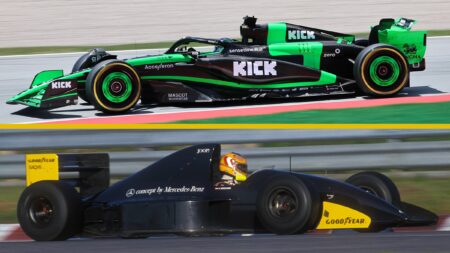
MotoGP celebrated 75 years of the motorcycle world championship last year at Silverstone with each of its 12 teams racing in classic liveries, inspired by memorable years or title-winning figures…
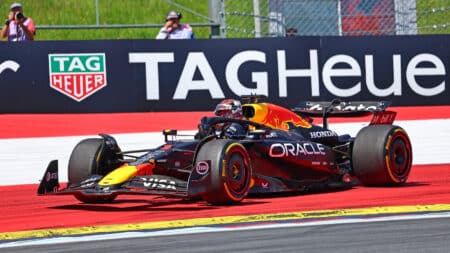
As F1 returns to Silverstone, Max Verstappen is slipping out of contention, Lando Norris is chasing a dream home win, and the midfield battle is tighter than ever
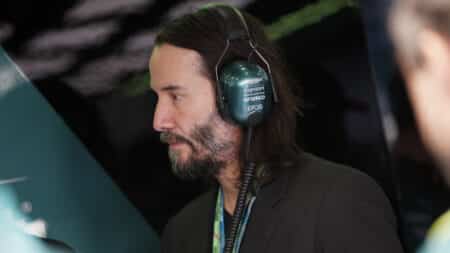
Hollywood star to tell "remarkable" story of American bid to join Formula 1 elite ahead of 2026 debut